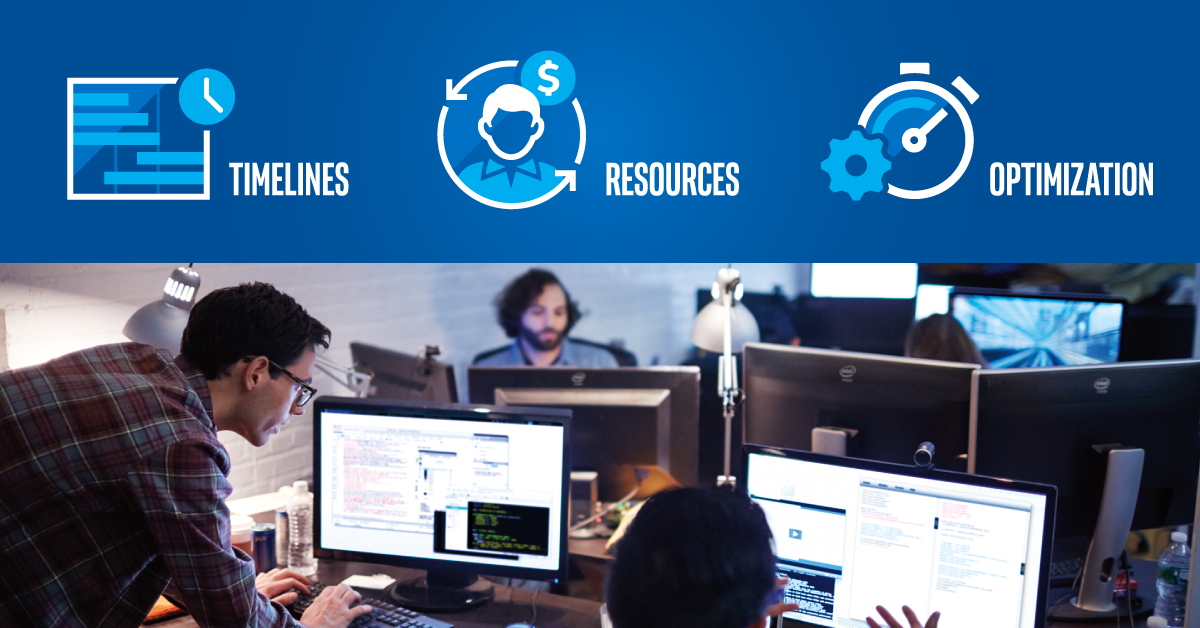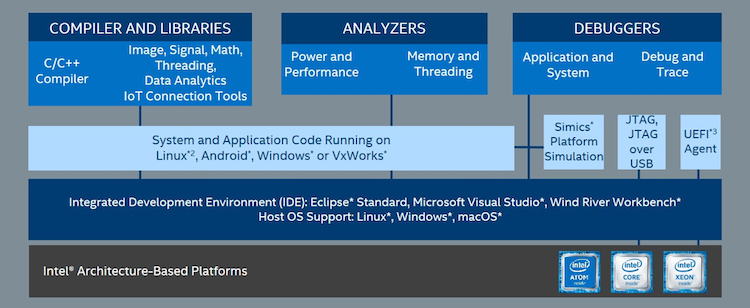Developing embedded devices is becoming more and more complex as sensing, compute, memory and communications technologies rapidly evolve. Teams face daunting software development challenges for devices, with shrinking timelines, scarce resources, and rigorous requirements for quality and performance optimization. But rest assured, there is a solution with the strength of Intel’s edge-to-cloud ecosystem behind it: the Intel® System Studio tool suite.

Three things have to come together for any development effort to succeed: timelines; optimization; and resources. This is true for any modern industrial product. However, software development is uniquely different from most manufacturing. It is a perfect blend of art and science. Unlike a typical manufacturing line stamping out car parts, every software program developed is unique, and in many ways, a reflection of you as the developer. There is always the opportunity to optimize your software—and nearly always, multiple opportunities to find bugs. When dealing with a very large code base and multi-featured hardware, it becomes a challenge to deliver quality software within time constraints, limited resources, and software that is optimized for quality and performance.

Most commercial companies have to constantly catch up with technology and market innovations, maintain price points and deal with intense competition. It is no surprise that most development teams are under constant pressure from squeezed timelines, limited resources and rigorous optimization requirements. Despite all that, developers are still expected to produce bug-free, high-performance code. If the developer team struggles with even one of those pressures, it impacts overall output and puts the product at risk.
Mitigating the Pressures on Development
You can mitigate these pressures by selecting the right tools for your project. Tools are your virtual team members, doing all the work that you don’t want to do. To select the most optimum tools, I recommend a three-prong strategy:
- Prefer adoption over assembling, or even building your own
- Ensure that you have covered every stage of your development
- Choose tools that are future-proof
Every development team has to struggle with “build vs. buy” decisions for their project. However, for development tools, it is generally not a good idea to spend precious time, resources and mindshare in building your own tools. Building your own tools is only half the effort. To maintain them over a long period of time with constantly changing technologies becomes very expensive. A simple rule of thumb is, “If your effort does not add any unique value to your end product that can be monetized, let someone else do it for you.”
When making tool decisions, review each section and stage of your development. Ensure that you have tools that cover the needs of developers working on every development stage. It takes a team effort to produce a complex software project, and you want to optimize every stage, avoiding weak links in the process.
Pay most attention to reviewing that your development tools are future proof.Technology evolution and market demands never cease. For example, new processors come out with new features, and you want to take advantage of them as soon as possible in compilers, debuggers and libraries.
The Pressures of Timelines, Resources and Optimization
Developers need tools that help them rapidly move from prototype to production while supporting the newest platforms and operating systems. That’s where Intel System Studio comes in. It’s a free, compressive tool suite that helps developers build in better performance with expert compiler and library optimizations. It makes it easier to isolate complex defects with debug and trace capabilities, and enhanced analyzers let developers improve performance and power efficiency.


Figure 3: Intel System Studio Development Environment
Compilers and libraries, analyzers and debuggers to fit a range of development needs.
Image shows the free Intel System Studio Ultimate Edition.
²Linux, Embedded Linux*, Wind River* Linux*, Yocto* Project
³UEFI: Unified Extensible Firmware Interface
Timelines: Faster, Higher-Quality Development
High-performance, production-quality routines can shorten product development time. Intel System Studio includes Intel® Integrated Performance Primitives, the Intel® Math Kernel Library, and the Intel® Data Analytics Acceleration Library.
With its Intel® System Debugger, Intel System Studio lets developers capture and view logs with time-stamped and correlated trace information for software, firmware, and hardware components. Developers can analyze complex interactions between software and hardware to make products more robust.
Resources: Edge-to-Cloud Connectivity
Developers of smart-connected devices need to reuse code and applications in the face of evolving sensor technologies and cloud services. To ensure edge-to-cloud compatibility and performance, developers using Intel System Studio can quickly convert ideas into reality with IoT connection tools that abstract the complexities of connecting the sensor to the device and the device to the cloud. Components include standardized, open-sourced abstraction libraries and sensor libraries to innovate IoT applications faster with access to advanced cloud connectors and 400+ sensors.
Optimization: Faster Operation
To quickly achieve extra performance, developers need to understand hotspots, monitor call counts, annotate source code, and graph activities. Doing so provides performance insights into CPU and GPU performance, threading performance and scalability, bandwidth, caching, and more. And as they support the latest Intel® platforms, developers can boost performance and efficiency by using the Intel System Studio suite’s Intel® VTune™ Amplifier, together with the suite’s code optimizations for capabilities such as Intel® Advanced Vector Extensions 512 instructions.
Innovate Today and Tomorrow with intel® System Studio
Software development, especially for embedded devices, is very complex, but tools like Intel® System Studio are specifically designed, and constantly updated to help address the complexity. Get started now with a free download.
The solutions that can be applied and optimized by this tool suite include digital security and surveillance, 5G, networking, industrial, data storage, healthcare, retail, smart homes/cities/buildings, automotive, and office automation.
About the Author
 Dinyar Dastoor heads up the Intel System Studio business. Before joining the Intel Software & Services Group in June 2017, he was VP and general manager at Wind River (an Intel company). With over 25 years of management experience in embedded, control and IoT products, Dinyar has built and led global teams in R&D, systems design and deployment, product management, sales, marketing and customer support.
Dinyar Dastoor heads up the Intel System Studio business. Before joining the Intel Software & Services Group in June 2017, he was VP and general manager at Wind River (an Intel company). With over 25 years of management experience in embedded, control and IoT products, Dinyar has built and led global teams in R&D, systems design and deployment, product management, sales, marketing and customer support.